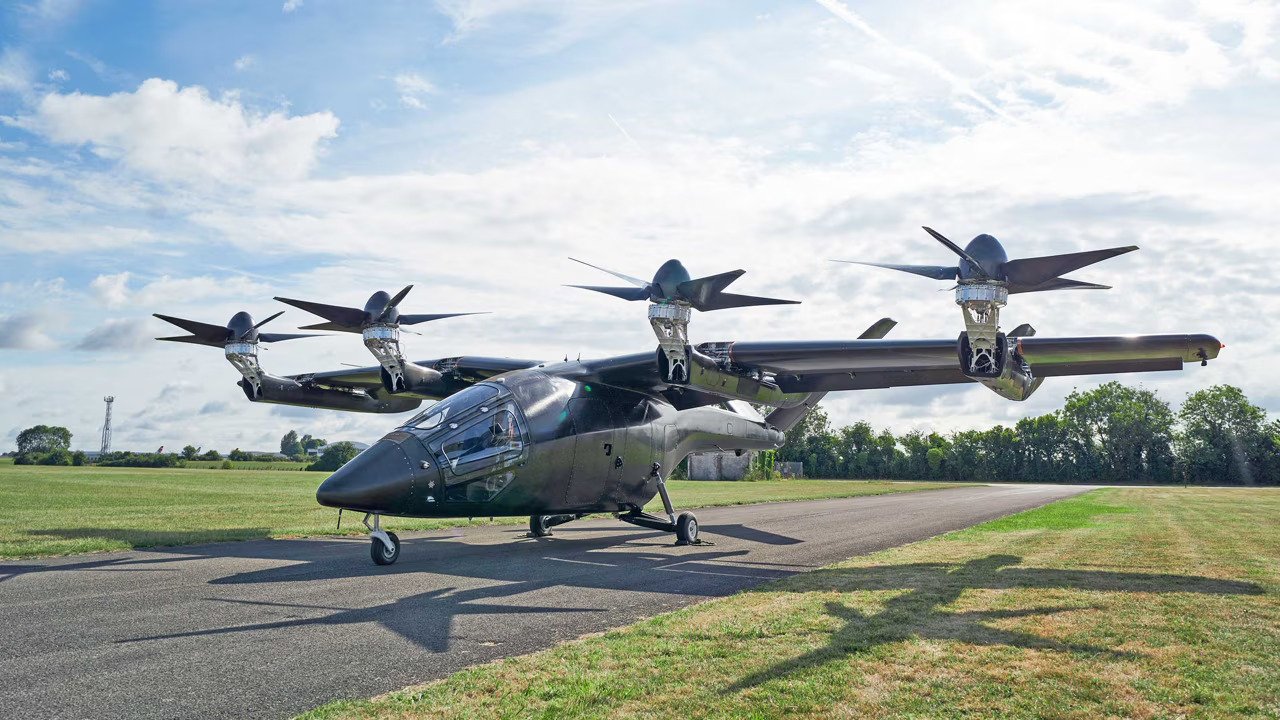Today, the UK Department of Transport offers a plan to get closer to flying in electric vertical take-off and landing (eVTOLs) aircraft. I can’t help seeing it as something of a wishlist.
The Future of Flight Action Plan was published today, and sets out the strategic direction of the sector over the next five years, striking a balance between innovation, security, safety and cutting emissions.
It includes a roadmap for drones and novel electric aircraft in the UK, which details:
- 2026: The first piloted eVTOL taxi flights.
- 2028 Regular eVTOL taxi services.
- 2027: Regular regular drone deliveries across our skies.
- 2030: Demos of autonomous flying taxis without pilots on board.
The plan was unveiled as part of a visit to Bristol-based eVTOL company Vertical Aerospace which is developing the VX4 aircraft, which fits four passengers and one pilot.
Last year the company progressed on its path to certification for the VX4, including securing the first-ever Design Organisation Approval (DOA) issued to an eVTOL manufacturer by the UK Civil Aviation Authority.
This approval means the Civil Aviation Authority is satisfied that Vertical has the capability to design safe and reliable aircraft and aviation-related products to the highest standards, and is expecting to streamline the steps towards obtaining Type Certification.
I've spoken to several eVTOL companies, and getting regulated is a long, slow process. The earliest innovators literally helped write the regulations as their tech began to evolve. They have yet to fly people commercially, let alone cargo.
According to the plan, eVTOLS like the VX4 will be able to join Liverpool and Leeds in just 26 minutes (as opposed to 1.5 hours by car) or Brighton and Heathrow Airport in only 20 minutes (currently 80 minutes).
It asserts:
“This will deliver desperately needed transport improvements to regions and locations suffering from a lack of connectivity.”
While it's great to see the local innovation of Vertical Aerospace, it’s a lot of heavy lifting for aircraft that will only be able to carry only a small number of people per trip at the expensive city-to-city rail or bus alternatives. Especially when you factor in the erosion of public transport in the regional UK.
You can't fly if you can't land or take off
The plan also details the development of vertiports — mini-airports for drones and electric aircraft that take off vertically — by developing certification standards and reviewing the use of existing infrastructure to deliver at speed, boosting safety and security and putting the passenger first.
This is significant as there’s no hope of commercial — cargo or people carrying — eVTOLs without the necessary infrastructure.
UK company Urban-Air Port opened the world’s first vertiport in 2022 in a partnership with the Supernal, the Urban Air Mobility division of Hyundai. It offered a pop-up demonstration that provided a taste into the experience of a dedicated departure and arrival facility specifically for electric and hydrogen VTOLs in Coventry, UK.
It then announced plans to build vertiport infrastructure with GKN Aerospace that year, with the hope to deliver over 200 vertiports across the world in the next five years. However, news from the company has been rather thin on the ground, suggesting .
Beyond that, we’ve seen slow progress in building dedicated vertical ports at airports or stand-alone sites.
An early idea was flying and landing on buildings.
Several investments have been made in placing vertiports on top of existing structures, such as eVTOL makers Archer and Joby partnering with Reef Technology in the US to turn the tops of parking garages into vertiports.
However, the structural integrity of such architecture is questionable, especially considering the lack of human elevators, and necessary power supplies.

Fortunately earlier this month Skyports signed an agreement to develop what it callsthe UK’s first vertiport testbed at Bicester Motion, Oxfordshire, a 444-acre estate dedicated to pioneering mobility technology, past, present and future. It's progress whichhighlights the regional approach, but I can't help feeling we've got a long way to go to get from a testbed to a regional commercial facility by 2026.
While the idea of regional eVTOLs is exciting, the realities of execution make it less certain in practice, and the timelines are something of a wishlist. I’m confident drones will hit UK skies at pace, but we’ll be waiting a lot longer to fly in an eVTOL taxi in the UK.
Lead image: Vertical Aerospace. Photo: uncredited.



Would you like to write the first comment?
Login to post comments